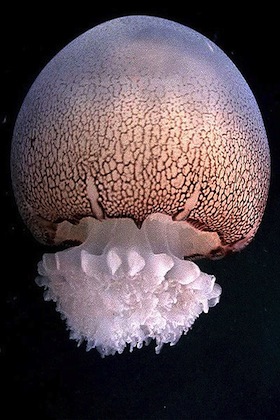360415-jellyball.jpg

A cannonball jellyfish. Credit: Dauphin Island Sea Lab
A jelly ball sounds irresistible — until you realize the flavor isn’t grape, strawberry, or peach. That’s because “jelly ball” is a nickname for a type of jellyfish — the cannonball. It’s about as wide as a small pizza, and shaped like a mushroom. But even though it’s not that appetizing to most American palates, the cannonball has become a popular target for the fishing industry along the southeastern coast of the United States.
The cannonball is plentiful there, where it’s been seen as a pest — it can clog pipes along the coast and cause other problems. But jellyfish are popular in China and other parts of Asia. So trawlers in Florida and Georgia began catching them in the 1990s. Georgia opened a full cannonball-fishing season in 2013, with the fleet hauling in millions of pounds since then. Since jellyfish are mostly water, they’re dehydrated with salt and other compounds before they’re shipped abroad.
There are concerns about the jellyfish business, though. The cannonball is a favorite food of the endangered leatherback turtle, for example, so taking too many of them could be a problem. And some are worried that jellyfish processing could foul the air and water.
While scientists monitor the impact on the ecosystem, the cannonball industry isn’t having much impact on American dining habits. The dried jellyfish is described as bland and chewy. And one fisherman compared it to the gristle on a chicken bone — a description that’s probably not going to help build a market for the jelly ball.

